
GEAR
A few tips and insights on gear and accessories I use and recommend.
Using the right gear is obviously essential and whilst things like bags are very personal I can at least give a few pointers in what to look for, you may get a few tips or see something you haven’t considered. There are tips for tripods, macro lights and a few accessories you may find useful too. These are all items I own and use so I feel qualified being able to recommend them.
LENSES
The three main lenses I use for landscapes are the m.Zuiko 40-150mm Pro, 12-100mm Pro and 8-25mm Pro. Although I do have other lenses, the 100-400mm, 60mm Macro, 17mm 1.8 and 45mm 1.8 to name a few, the three below are the lenses I use most.
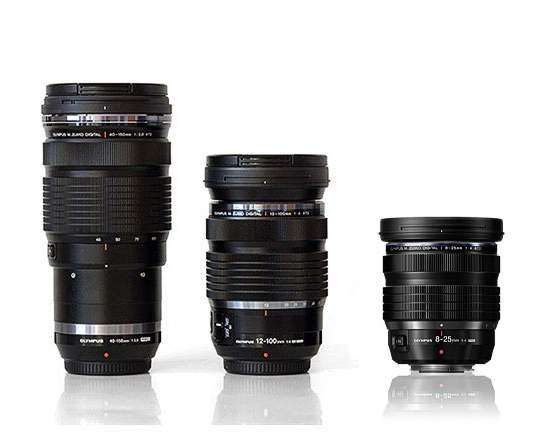
1) 40-150mm f2.8 Pro
The ideal lens for long landscape images, it has a great range and is not too long for landscape work. Other lenses like the 300mm Pro are I find too long and better served for wildlife, although of course it can be used for landscapes. The 40-150 is razor sharp and is already firmly raised on a pedestal for being one of the great Olympus lenses. Its also good for wildlife and combined with the 1.4 teleconverter it has additional flexibility.
2) 12-100mm f4 Pro
One of the best all rounder lenses in the Olympus lens line-up, it has for me replaced the 12-40 because of the range, making it ultra flexible. Not the fastest lens at f4, but it is a general purpose lens and with an additional stop of stabilisation built in it makes up for the slower aperture. For landscapes it doesn’t need to be faster. For someone like me who loves wide angle lenses they do not suit every location. The Lake District for example I find the 12-100 much more suitable, images are in general less about close foregrounds and wide lenses will push background fells further away.
3) 8-25mm f4 Pro
Although I also have the 7-14 f2.8 Pro the 8-25mm has largely replaced it for landscapes. The 7-14 is now reserved for low light and night photography, not that I do a great deal. The 8-25mm has a better range, and for someone who loves wide lenses the slightly longer reach is useful. Wide lenses need a good foreground, a location like the Peak District is perfect for wide lenses, and without a good foreground a wide lens is wasted. The main reasons for swapping to the 8-25 is the filter thread, much more convenient for using filters than the 7-14 though of course it is possible, and the reduced lens flare. I do find the 7-14 flares easily because of the convex front element, and is prone to sensor flare which is a devil to remove. The 8-24 is very sharp, not quite as sharp as the 12-100, but a little sharpening in post makes up for it. It is slower that the 7-14 obviously, but its a landscape lens; they tend not to move too fast.
CAMERA BAGS
My weakness, I love a good camera bag. Just like the cliche of women and shoes many photographers have far too many bags, I must have 10. Time to sell a few I think. The obvious pointers are storage and comfort, external pockets for sliding hats and gloves in, drinks bottle pockets and straps for attaching a coat or tripod. Personally I never strap a tripod on my backpack but I do often strap a jacket on for when it gets colder. What suits you will dictate the type of bag you go for, a backpack, shoulder bag or both depending on situation.
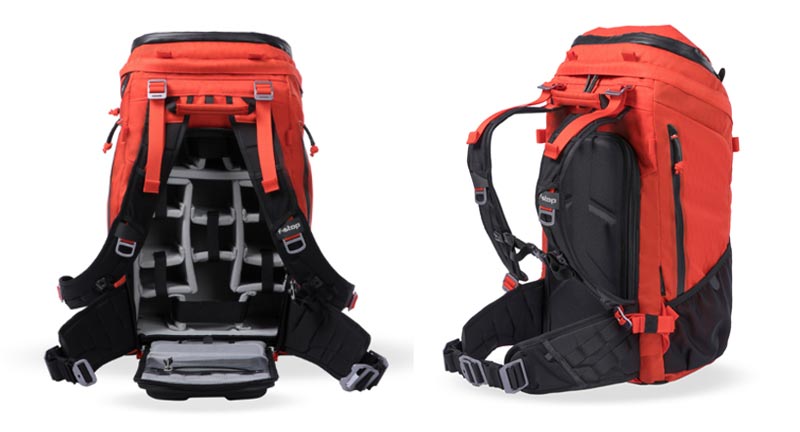
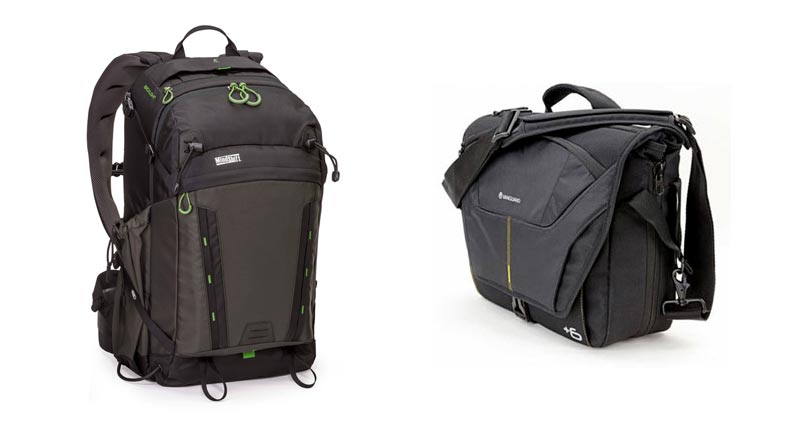
1) F-STOP AJNA 37L
I am a huge fan of the F-Stop backpacks and use the Ajna 37L (shown) and the larger Tilopa 50L. Admittedly not cheap the Ajna will set you back £350 plus another £100 approx for the ICU. Based around a light outer shell with an aluminium frame different size ICU’s (Internal Camera Unit) can be inserted depending on your trip; insert a small ICU for a camera and lens and have the rest for clothing etc if you’re going on a long hike. Plenty of zipped side pockets and a large front storage pockets accommodate just about anything. The best thing is the top zipped lid which opens to allow quick access to a large storage space for gloves, hats, head torches etc, and a smaller top pocket for a map or mobile. Tip, get the straps with it, they can be fitted on the top, sides and or front and they are great for strapping a coat on. Buckles are now aluminium for strength and it will also accommodate a drinks bladder.
F-Stop Website – My Workshop Clients can get 15% off please contact me.
2) THINKTANK MINDSHIFT BACKLIGHT 26L
For a relatively small backpack the Mindshift Backlight 26L is one of the best I have used and one of the comfiest. The front pocket is huge and can easily accommodate a jacket or fleece which is what I look for in a backpack. There are dividers too to separate items. The interior of the main body can actually hold a huge amount of gear, easily two bodies four lenses and accessories. What it lacks is exterior zipped pockets other than the front, but it is still a great backpack. Rear access is a must for any backpack, when it is put down on wet ground it is the front that will get wet, avoid any that have front access or you get a wet dirty back.
3) VANGUARD ALTA RISE MESSENGER BAG
Messenger/Shoulder bags may be your thing, personally I don’t use one as my main bag because all the weight is on one shoulder or across the chest. The reason I have one is because they are great for on the coast when you know you will be standing in water and cannot put your bag down. Most rear access backpacks allow for you to spin it round and open the back but in winter with a coat on its never easy. Another good reason to have one is if just popping out for a few quick shots you can take just what you want and leave the rest at home.
It looks like at the time of writing the Alta Rise has been replaced with the VEO Select range which maintains the two best features, a top zipper access and internal unit which can be completely removed to turn it into a standard bag. And they make great tripods too.
TRIPODS
As someone who has owned and still owns too many tripods I’m pretty well qualified to advise. With the amount of image stabilisation in camera bodies these days including Olympus tripods seem less important, but they are. By all means enjoy the freedom of shooting hand held, I do more and more. But a tripod is still needed for Long Exposures, bracketing (although it can easily be done hand held too) panoramic images, and Macro. The main point of a tripod which is overlooked is to slow you down. Consider the scene and your composition, take your time, make adjustments and wait for the light.
There are hundreds to choose from, and an old addage still remains true today, tripods can be cheap, sturdy or light; pick two because you can’t have all three.
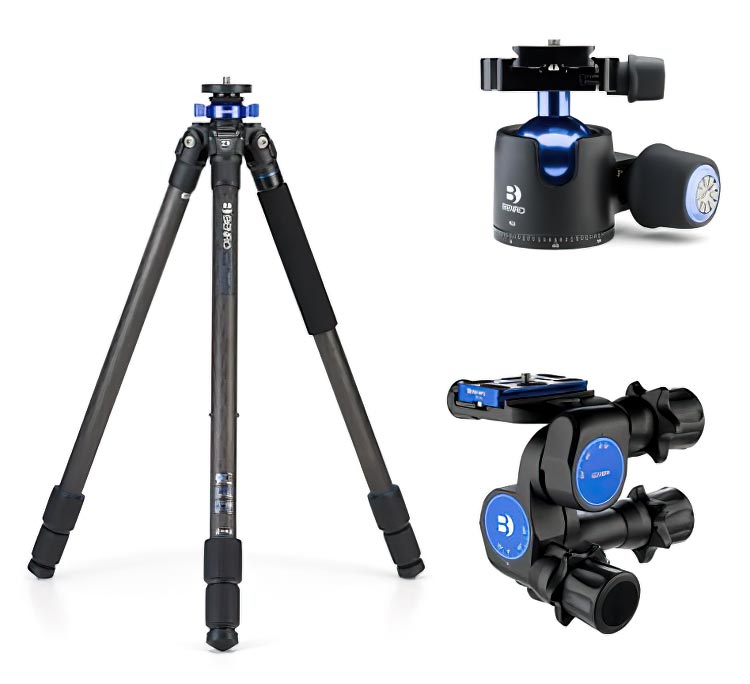
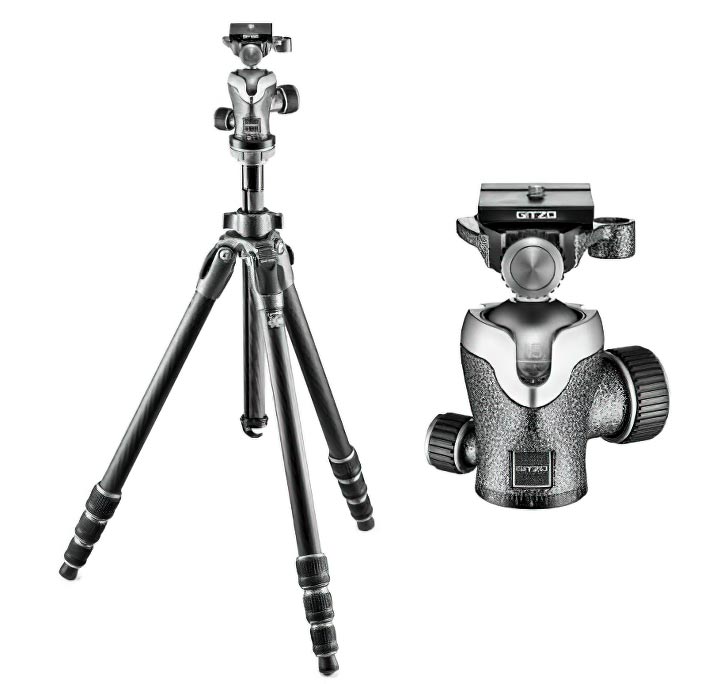
The main points to look for in a tripod are height, weight and sturdiness.
HEIGHT – Select a tripod with the greatest height excluding the centre column which should only be used as a last resort, it will introduce the most vibration. The higher the better without the centre column. It will also be more convenient when spanning across gaps.
WEIGHT – The least weight is obviously better but selecting a tripod based just on this is false economy, it probably will not be sturdy enough and a tripod a few hundred grams more really isn’t a big deal yet will be stronger. Carbon Fibre is lighter but at a cost. More leg sections means a tripod is more compact but is also heavier, not a great deal more but it will add to it. Travel Tripods are usually exclusively just for that, travelling. I would not rely on a travel tripod as my every-day tripod unless it is of significant quality and quality comes at a price. Better I think to have a main tripod and get a cheap travel tripod on Amazon that will do the job of a long exposure in St Marks Square and last quite a while because it gets little use.
STRENGTH – If is isn’t sturdy it isn’t fit for purpose and a waste of money. This really should be priority. Overall weight it will hold isn’t a good indicator either, a tripod that can hold 20kg may vibrate with just a breath of wind. Wind and running water are the enemy and legs that are not stiff will vibrate with the slightest movement transferring through to the camera. Number of leg sections also make it weaker, so less is better though it impacts the minimum length. When travelling ball heads and columns can be removed so the length never bothers me too much. Also the more leg sections the thinner the last leg section will be. I would avoid any tripod with leg sections less than 15mm diameter, they will vibrate like a guitar string.
ARCA SWISS COMPATIBLE – The top plate should be Arca Swiss type, a wedge shape, which opens up availability of tripod plates and brackets. Some brands like Manfrotto make the plates generic to their accessories, so if you want an L Bracket you have to pay for one of theirs, and you do pay though the nose.
1) BENRO MACH3 37C
Although I have a Gitzo Systematic I much prefer the Benro, in fact this is as near a perfect tripod for general use I have found. It has a height of 138cm and will extend 163cm with the column. The column can be replaced with a short column (included) for getting very low, it is very sturdy with the lower leg section being 25mm diameter, and Benro supply superb bags with their tripods. The Mach3 comes with tools and ground spikes too which I always use. At 1.7kg it really isn’t a great deal more than some travel tripods so for the strength and reliability of it I really cannot fault it. Leg locks too are a nice size and easy to grip, I can undo both on each leg at the same time with a short twist. Beware of some leg locks which have a rubber outer sleeve, they can slip when they get wet meaning you cannot grip them.
The Benro G2 Ball-head is one of the two very best engineered ball-heads I have ever used, the other being Gitzo. It is quality engineering. A large knob which has a friction control in the end is easy to grip and requires only very gentle pressure to lock solid unlike some which practically need a wrench. I avoid any that have right-angle levers, they are too easy to snag a coat sleeve on and undo. A knob at the back allows the base to rotate and it is Arca Swiss Compatible.
The GD3WH3 Geared Head is very good too with precise controls and a quick release function for making fast adjustments. Gear Heads are great for making very precise adjustments and I do use the geared head although I have to admit I am quite happy with a ball-head, it is lighter and less bulky.
Benro Website – Shop around because you’ll find better prices.
2) GITZO S2 MOUNTAINEER
A superb tripod and so it should be for the eye watering cost of it, but I found one believe it or not on Amazon with over a third off. This is a cross between a general purpose and a travel tripod. At only 1.6 kg including the very solid ball-head it is very good and has a max height of 176cm including the column. Despite being a 4 section tripod the last leg is 15mm diameter so it is strong and doesn’t flex. One of the best features is the quick release plate just under the ball-head; twist it and the centre column can be removed leaving a short column for very low level shooting. Whist this is a Rolls-Royce tripod with the price of the ball-head being around £300 I paid around £150 for the legs which was a bargain. Hunt around and you will be surprised what you may find. Benro also make very good travel tripods as do Three-Legged Thing, but those colours! Yuk. I only include the Mountaineer as an example of the quality to look for, just because a tripod is compact doesn’t mean it should be inferior. Compromise on quality and you may as well not bother. A good tripod should last a long long time.
The Gitzo GH1382QD Ball-Head is a marvel of engineering with similar qualities of the Benro G2, just to emphasise that the tripod head needs to be considered carefully. I’ve had cheap ball-heads fail on me or ended up having to tighten them so much they were a pain to use.
K&F TRIPODS
For more budget friendly tripods including aluminium and carbon fibre you really cannot beat K&F. I use this model the KF09 aluminium 170cm. It has centre column which rotates horizontally and it can be reversed making it great for getting low.
I use it for macro fungi images in the woods and use additional clamps to fit lights. For around £100 including the ball head it is very good value. Check out the carbon models too for something lighter.
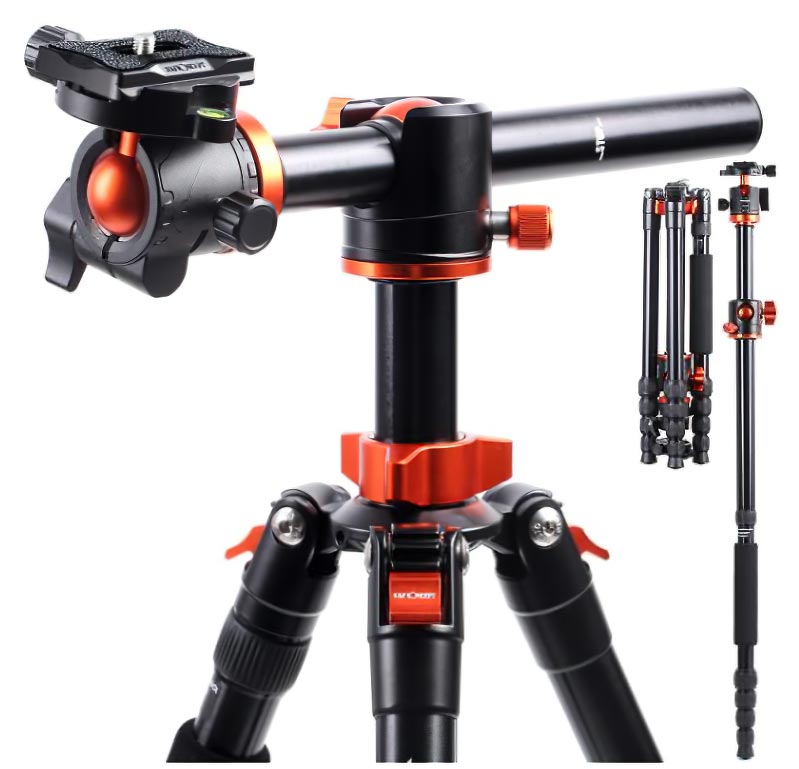
FILTERS
If you studied my website it will be no surprise that I use Nisi filters being an Ambassador and a stockist, and you will find a great deal of information about them on the relevant pages. But what are the benefit of using filters? Filters are used for two main purposes, balancing exposure and lengthening exposure.
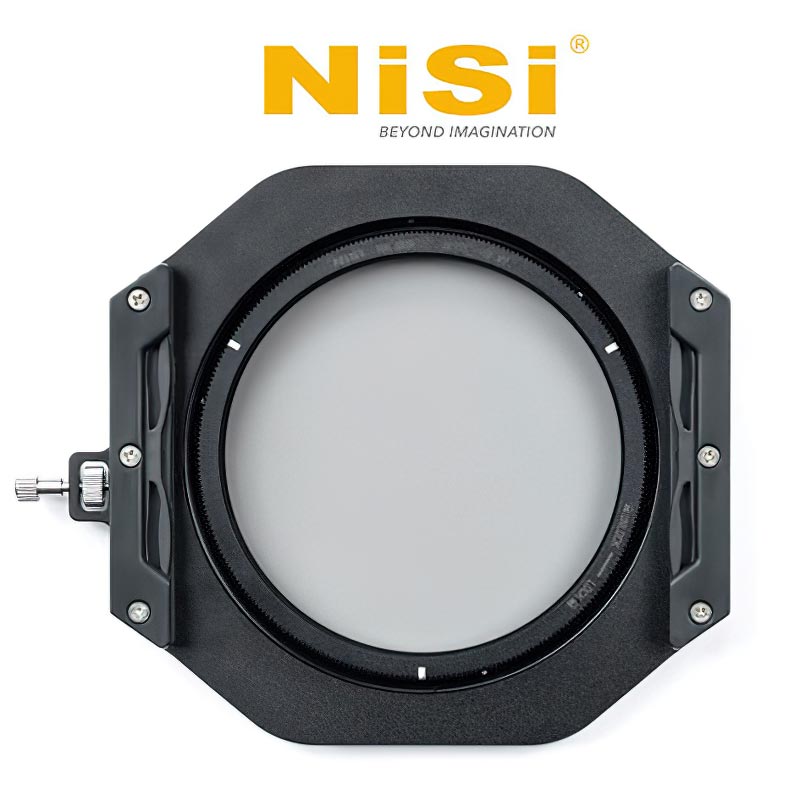
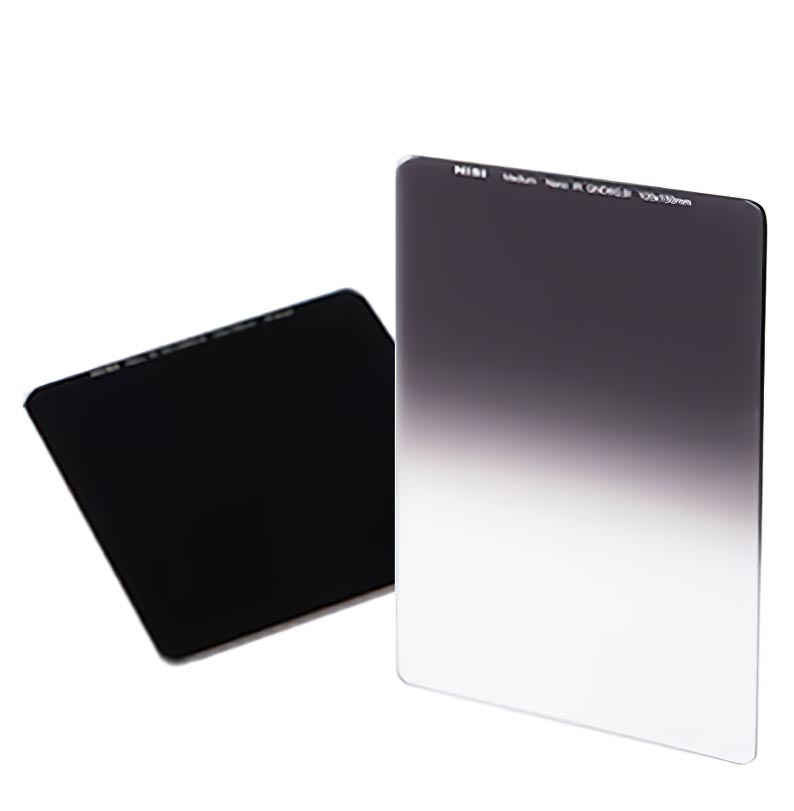
1) NISI V7 FILTER HOLDER
Comprising an adapter ring and step rings on the rear for different lens sizes the V7 includes a 100mm filter frame and a polariser. Polarisers are essential for landscape photography to remove reflected light from foliage and water, and for saturating colour although care must be used with wide lenses. Although some other filter sizes are available such as 75mm they will not suit wide lenses such as the 8-25 so you are better to use 100mm. The V7 is a great piece of equipment, and whilst circular filters are also available with less bulk you cannot use graduated filters. More flexibility is provided with a slot in system.
2) ND FILTERS
ND filters are a solid tone and reduce the light entering the lens, thus extending the shutter speed to create long exposure images. With the OM-1 having up to 6 stops built in a 10 stop is useful to have for longer exposures. A 3 or 6 stop is also useful to extend the built in ND, use an external 3 stop with the built in ND’s but remember when using Live ND the maximum shutter speed is 60 seconds.
3) GRADUATED FILTERS
A graduated filter will bring the exposure of bright skies down enabling the camera to better capture the dynamic range in a scene. At the same time as reducing the brightness of a sky the ground will also reveal more detail because the camera is not being dazzled, just as graduated sunglasses help us see the ground in front of use. Graduated filters are available in different strengths for 1 to 5 stops and different graduations, soft, hard, medium and reverse. The most useful filter to have I think is a 3 stop Medium Graduated, it will serve you well for just about all scenes and a kit of other filters such as a soft can be added as and when needed.
L BRACKETS
For me personally an L Bracket is essential. They replace a standard tripod plate with and L shaped bracket making composition for portrait orientation much faster. I shoot many images in portrait, I’m fond of how a viewer’s eye can be drawn into in image this way. It is always such a faff altering ball-head and even more so a three-way head, and it means the camera is off the tripod centre of gravity, not a good idea. Composition is maintained with only minimum adjustments needed between landscape and portrait too.
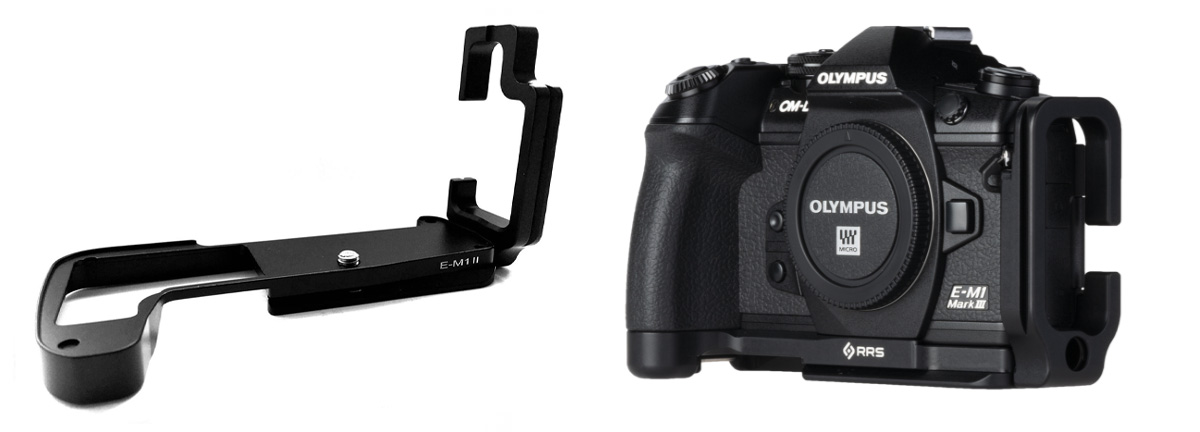
REALLY RIGHT STUFF
The very best L Bracket made for the E-M1 MK 2 and 3 is the really Right Stuff bracket. Beautifully engineered, with rounded edges, a vertical section which can extend out and a magnetic Allen key hidden in the base it really is the very best, but so it should be for approx £250.
There are a multitude of standard L Brackets available, cheap generic models and some designed for specific cameras, Three Legged Thing produce the Ellie which may suit you. For me these do not cut it, full width brackets have lips on them designed to fit the camera base, and the RRS bracket has a pin which locates into the hole on the camera base where the Olympus Battery Grip also has a pin which locates into it. The lips and the pin are designed to stop the bracket twisting sideways, something standard L Brackets always do because they rely on just the bottom screw and a bit of rubber.
Search online and you will find a multitude of suitable brackets like the RRS bracket and the Amazon Bracket which cost £20.
RELEASES & TRIGGERS
You need a cable release, you really do, no two ways about it. Many functions such as Long Exposures and High Res may suffer from vibration when pressing the shutter manually, and some features such as bracketing do not allow the Self Timer to be enabled. The Olympus I.O. App can be used to pair with your mobile and it works very well, not only can you download images but you also get a Live View too.
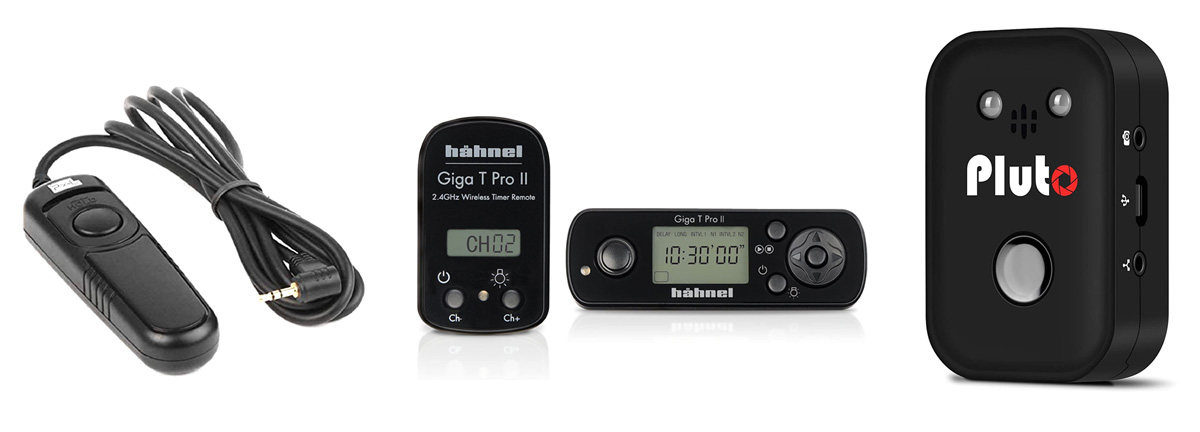
OLYMPUS IMAGE SHARE
The Olympus Image Share App can be used as a wireless trigger and for downloading images to your mobile too. It does the job very well indeed and the best feature is a live view of your camera screen on your mobile. Great if you want to be in the shot. It does have limitations, it only uses standard shooting modes and it cannot access your Custom Modes, connection distance can also be sketchy sometimes. It is worth trying though.
WIRED CABLE RELEASES
My preferred option, the image is a Pixel remote from Amazon costing £8. Wired releases are nothing more than a cable with an electrical contact button on the end so I see no reason to pay £80 for OEM releases. I tend to buy two at a time because I lose them. There are plenty available with different brand names, just look for any with a Canon E3 jack which is the same as Olympus.
HANNEL GIGA T PRO II
The Giga T Pro has been around a long time now and is half the price it used to be, around £30. Although the built in intervalometer is a little redundant because the camera also has it built in (Interval Shooting), it is a very reliable and easy to set up wireless trigger with a long range too of 100m. The transmitter fits to the hot-shoe and connects to the camera via an E3 cable. The cable can be connected to the trigger to use as a standard wired release. Other cables are available for different cameras too. I have one of these but prefer the Pluto because only one battery is needed.
PLUTO WIRELESS TRIGGER
The king of wireless triggers, and compatible with a huge range of cameras via suitable cables. The transmitter unit is rechargeable which is very convenient. Operated by a phone App there is little this little thing cannot do which makes it ideal to use for multiple cameras. Some features may be a little redundant because of the camera features, like shooting lightning with Live Comp. But this device will trigger a shot when it sees lightning. It can bracket up to 19 shots, shoot star trails, trigger a shot by sound, or by the included laser beam, run time-lapses and a host of other features, too many to mention. It isn’t cheap at around £120.
PEAK DESIGN CAMERA STRAP
Camera straps are a pain when using a tripod, they get in the way and flap about in the wind causing vibration.
The Peak Design Slide strap solves that with strong anchors that are attached to the body (they are strong!) and a strap with very easy to use quick release buckles.
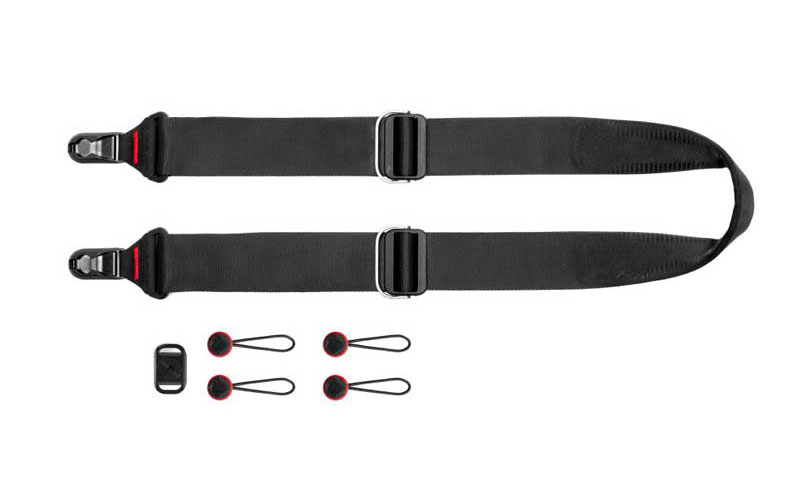
QUNTIS MONITOR LAMP
The best accessory I’ve ever bought for my computer, a 40cm LED strip light. It simply clamps to the top of my monitor and with directional light it illuminates the desk and not the screen so I can see my keyboard.
It uses no power being LED, it has manual brightness or auto sensors and colour temperature can be adjusted. At around £30 its also £100 less than the very similar BenQ monitor light.
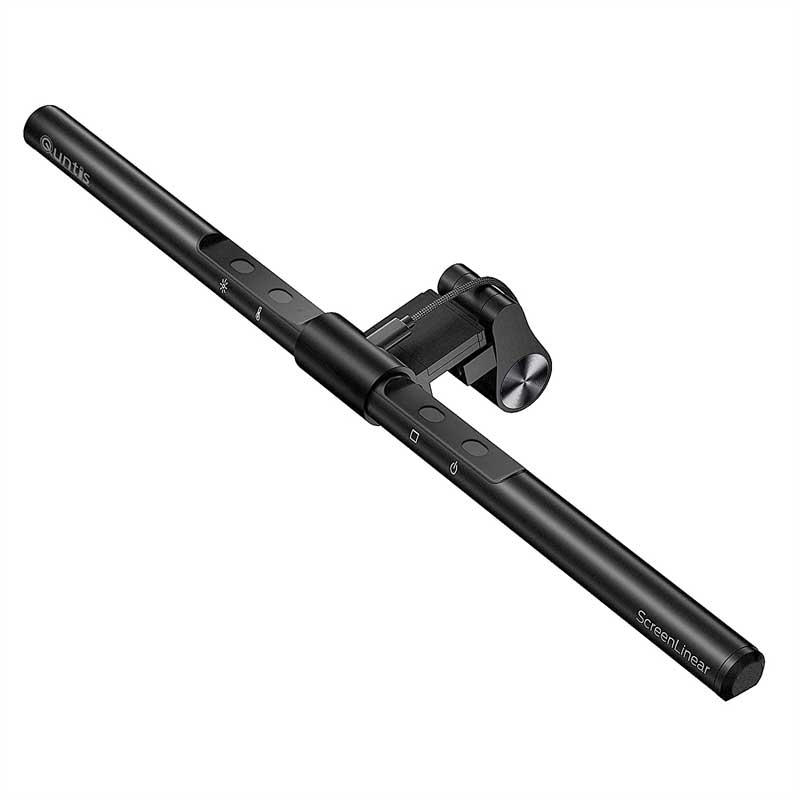
TORCHES
It goes without saying being able to see at night is essential, these are my two favourite accessories for being able to light my way when out after dark.
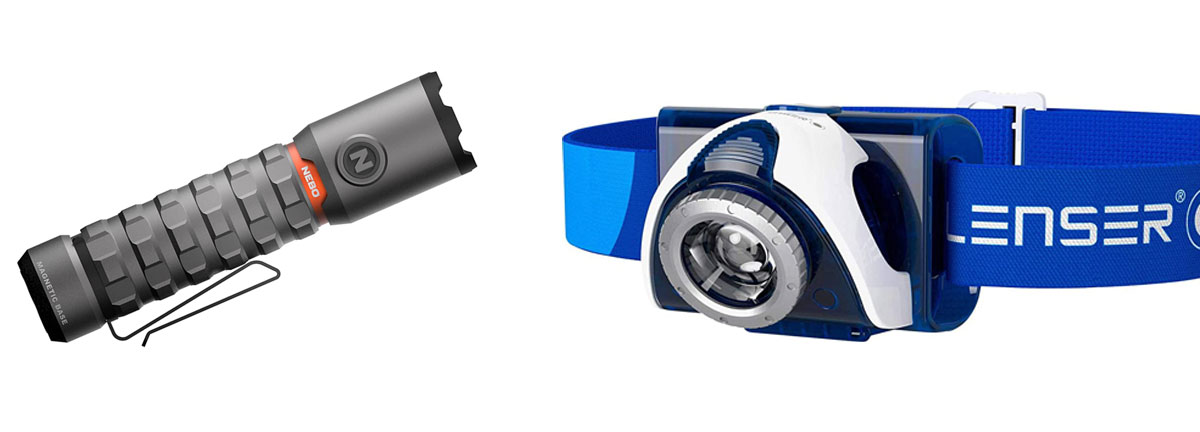
NEBO TORCHY 2K
My favourite LED torch because its so small at only 10cm long, and it packs power at 2000 lumens. Brightness is adjustable but it doesn’t have adjustable beam which for me doesn’t matter, I want something small to fit in a pocket without bulk with a wide bright beam. This does the job well and it is rechargeable so no more messing with batteries. Also weather sealed and still worked when I dropped it in a stream.
LED LENSER HEAD TORCH
LED and rechargeable, handy when you have a battery pack, it will last quite a few uses between charges and my experience is it has never lost charge when not in use. At 220 lumens its very bright for a head torch, light weight and has an adjustable beam width, adjustable angle and also adjustable brightness levels. For night photography it also has a red light mode to reduce glare. All pretty much standard these days but Lensers do have a good build quality and reputation.
GORILLAPOD & PANEL LIGHT
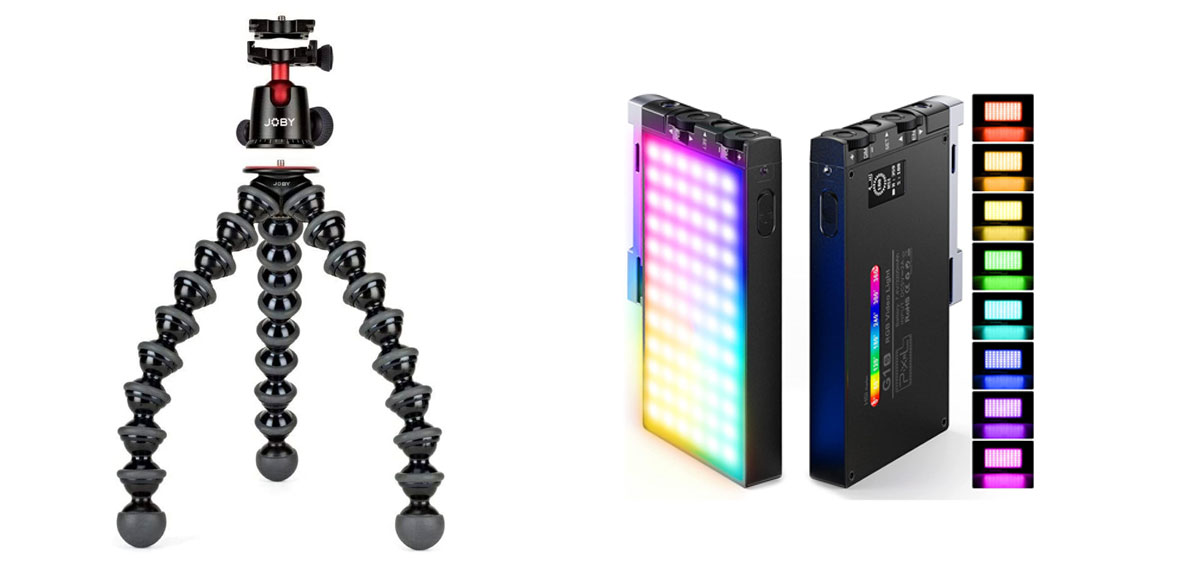
JOBY GORILLAPOD 5K
There are quite a few bendy tripods available these days but the Joby is still the original and best. Useful because they are so small and light and easily fit into a backpack side pocket, and they are great for getting really low or for wrapping around tree trunks, walls and fences etc. I use one for my ‘Glowing Shrooms’ series of images when I want an additional support for a panel light, torch or Macro lights like the Adaptalux below.
The 1K is around £30, the 3K £50 but it is worth going for the 5K for £20 more because the ball-head is far better and it is Arca Swiss so a standard tripod plate will fit as will an L Bracket. I had the 3K but ended up buying the ball-head separately for the Arca compatibility.
PIXEL G1S LED PANEL LIGHT
The Pixel Panel Light is a small unit about the same size as a mobile phone at 12cm. I use one when I want to add a little background ambient light to Macro images (‘Glowing Shrooms’ again). Along with white it has a full spectrum of RBG colours and brightness can be adjusted from the full 1500 lux to 0. The best feature of they unit is the build, with an aluminium case, easy to use wheel controls and a metal swivel base for angling it out. It also has a hotshot adapter and a small ball-head for more flexibility.
ADAPTALUX MACRO LIGHTS
What on earth, you are probably thinking. A friend recommended these to me and they are genius for lighting Macro Images. Instead of being behind the camera trying to run focus bracketing and stretching trying to hand hold a torch (see ‘Focus Bracketing’) or using a clamp, these bendy LED arms are powered by a control unit and can accept up to 5 arms. The whole set is controlled by a phone app which juts uses Bluetooth so doesn’t rely on a mobile signal.
They are not cheap at around £300 for a kit with two lights, but they are worth the investment. A tripod bush on the base allows it to be tripod mounted or used on a GorillaPod.
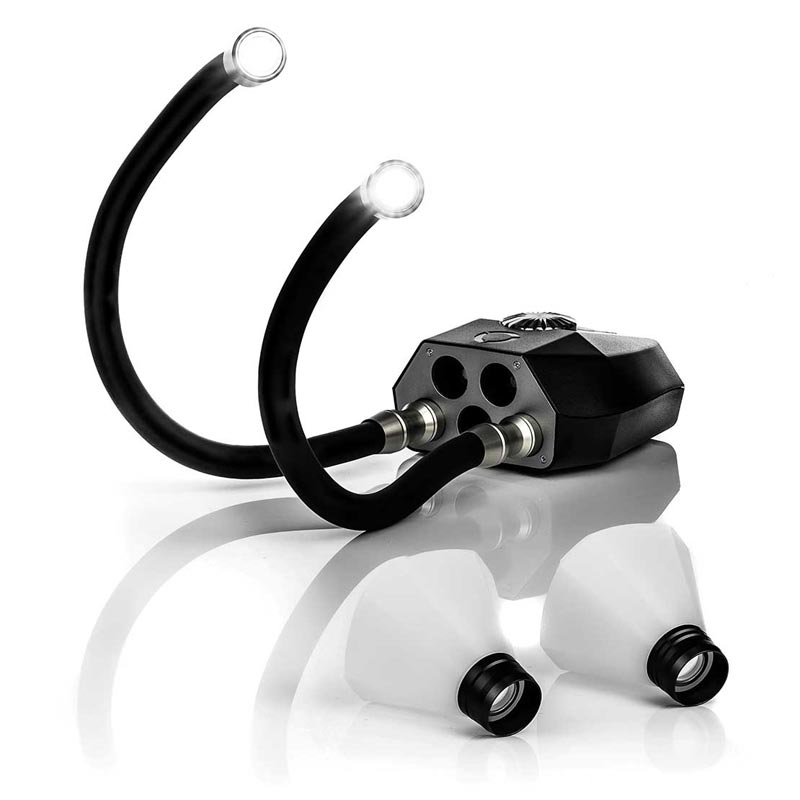
MACRO
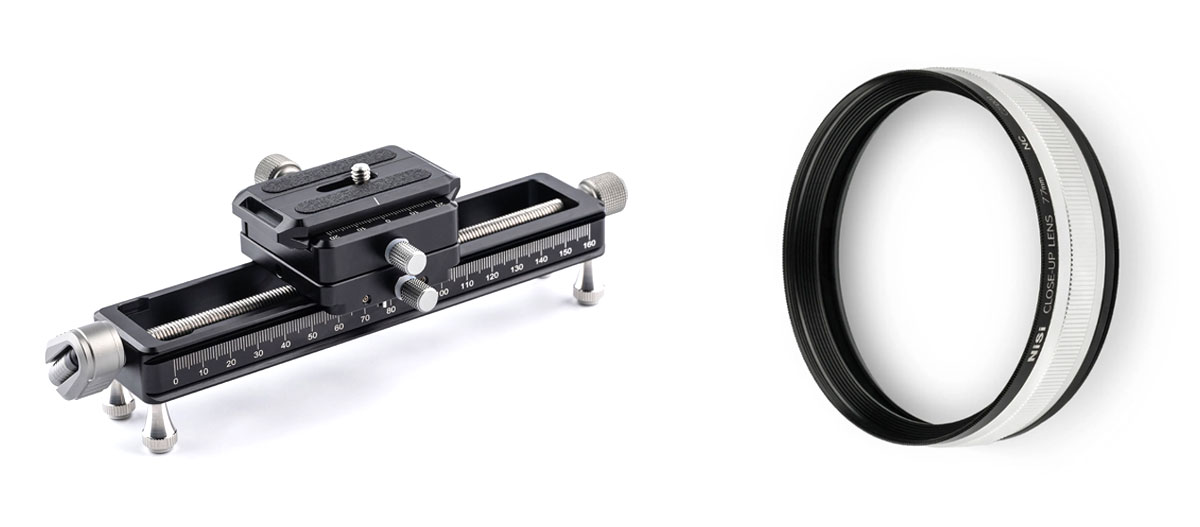
NISI MACRO RAIL
Incredibly well engineered the NiSi Macro Rail solves the problem of making minute adjustments in Macro photography. An Arca Swiss compatible rail with removable table top feet has a tripod plate which can be adjusted by a mechanical screw thread. Make minute adjustments with the rear thumb screw or for bigger adjustments pull the lever out to wind the mechanism faster. The top plate can also be rotated a full 360 degrees.
NISI CLOSE UP LENS
The Nisi Close Up Lens does exactly as the name suggests, giving a closer focus distance to longer lenses which do not focus very close and can provide up to almost 1:1 magnification. Designed for longer lenses such as 70-200mm (Full Frame) it is suitable for the Olympus 12-100 at around 50mm and over, and lenses longer than this. With a 77mm rear thread a 67 and 72mm step ring are also included and other threads can be accommodated with a suitable step up ring.
BRACKETS
I’ve included these simply because it’s surprising how many people ask what I use when they see me posting Behind The Scenes images on Social Media.
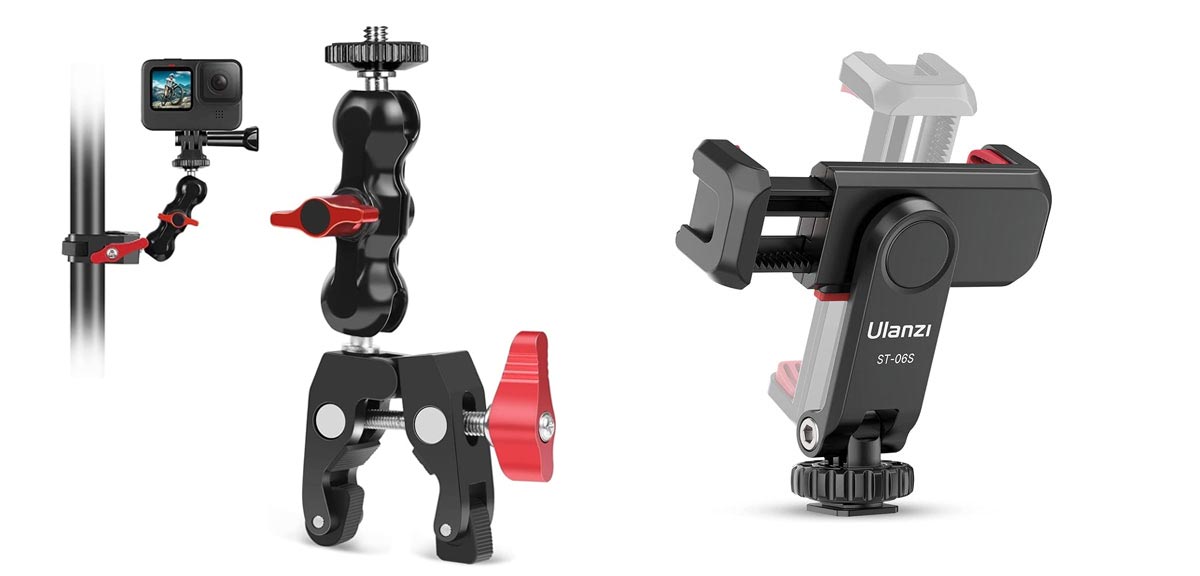
PULUZ ARTICULATED BRACKET
It’s amazing just how useful these are. With a 1/4 thread at the top anything that has a tripod bush on the base can be mounted to it and then clamped to anything. I used it for mounting a Go-Pro to the tripod leg for doing a time-lapse. I soon realised Go-Pros are not for me, for doing a Behind The Scenes or a time-lapse my phone does the job, so I just mount the phone bracket to it. As long as I’m steady I can carry on using the camera too because I’m not using the hot-shoe. It has also been useful to attach a manual light to a tripod leg too. The odd looking arm is actually a bonus because it will angle in just about any direction. It can be extended with longer arms too and for around £15 it really is a great accessory.
ULANZI PHONE BRACKET
Useful for hands free video or time-lapses from a mobile there are so many of these around now. I do like this one because it is light but strong, it rotates and the base is articulated so I can angle it. The base has a hot-shoe foot but also a 1/4 tripod bush so I can mount it to anything, the Puluz bracket or even a standard tripod plate.
CONCLUSION
I hope these have been useful. These are all items I actually use and whilst there are many more it would be hard to show everything. Please not that items with an Amazon link are affiliate links so if you wish to purchase anything I may just earn enough credit for a gift voucher and it is appreciated.
